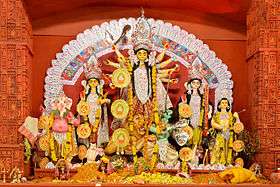Mahishasura
| Mahishasura | |
|---|---|
|
A statue of Mahishasura in Chamundi Hills, Mysore |
According to Hindu mythology, Mahishasura was a combination of both an Asura and a mahisha ("water buffalo") with a trident. He intended to annihilate all the Devas since they were the arch-enemies of Asuras. The legend of Mahishasura is important in Hindu mythology since the goddess Durga was incarnated in order to slay him. Therefore, his story is an important part of shaktiism which venerates the goddess Durga.
The legend of Mahishasura


Rambha, the king of Asuras, was enticed by the beauty of a she-buffalo and eventually married her. The child who was born from this union was named Mahishasura because he was both buffalo as well as human (mahisha literally means buffalo). As an Asura, Mahishasura wanted to wage war against the Devas, as the Devas and Asuras' were perpetually in conflict. To make himself invincible, Mahishasura performed austerities (tapas) to Brahma, propitiating Brahma to confer upon him immortality. Brahma refused him the boon of immortality; instead, Brahma gave him a boon such that his death would happen only at the hands of a woman. Mahishasura imagined that this was the equivalent of immortality since he believed it was impossible for a woman to slay a person of his strength.[1] Emboldened by this belief, he started a war with the Devas. In the battle that ensued, the Devas, led by Indra, were defeated. At this point, the Devas approached the trinity of Shiva, Brahma and Vishnu to seek help. The three great gods combined their divine energies and created a woman. The Goddess thus created was Durga. Durga led a battle against Mahishasura and killed him, thus fulfilling the prophecy that he would meet his death at the hands of a woman.
Mahishasura in Art
Durga slaying Mahishasura is a prominent theme which was sculpted in various caves and temples across India. Some of the prominent representations are seen at the Mahishasuramardini caves in Mahabalipram, the Ellora caves, in the entrance of Rani ki vav[2] Hoysaleswara Temple in Halebidu and many more temples across India.

The worship of Durga during Durga puja in West Bengal is done to the idols of Durga which depict Durga killing Mahishasura.
Mahishasura and Mysore
The popular legend is that Mysuru gets its name from Goddess Durga, Mahishasura Mardini. It is believed that the people of this region were saved from the Buffalo Demon Mahishasura who had come and occupied the land. This is when people prayed to Goddess Durga for help and she descended during a sacred period which is now called Navratri and Dushera. Thus, the Nine days battle took place on the Chamundi Hills where he was slain at last.[3] Hence, the Dusshera festival is the biggest festival and this is also called Nada Habba which means, the State Festival in Kannada and is famously known as Mysore Dasara. The temple of the city’s guardian deity, Chamunda has a giant statue of Mahishasura. In Sanskrit Mahisha means a buffalo. There is a popular story to substantiate the association of a buffalo demon slayer with the city’s name. The earliest mention of Mysore in recorded history may be traced to 245 B.C., i.e., to the period of Ashoka when on the conclusion of the third Buddhist convocation, a team was dispatched to Mahisha mandala, the region that was once occupied by the demon, for propagating Buddhism, which also emphasises its association with buffaloes.[4]
.jpg)


Mahishi (Mahishasura's Sister)
In Kerala, there exists a parallel mythology according to which, Mahishasura had a sister by the name of Mahishi. After the death of Mahishasura, Mahishi continued the war against Devas.
See also
- Asurs of India
- Asur tribe of Adivasis
- Santhal people
- Chanda
- Chandi di Var
- Durga Puja
- Markandeya Purana
- Munda
- Raktavija
- Sumbha and Nisumbha
References
| Wikimedia Commons has media related to Mahishasura. |
- ↑ Mahishasuramardini. "mahishasur". www.maavaishnodevi.org. /www.maavaishnodevi.org/. Retrieved 26 January 2016.
- ↑ mahishasuramardini. "Rani ki vav". http://www.frontline.in/arts-and-culture/heritage/a-queens-tribute/article6675794.ece. frontline magazine. Retrieved 26 January 2016. External link in
|website=(help) - ↑ "Mysuru name". http://www.mysore.org.uk/mysore-history.html. Retrieved 27 January 2016. External link in
|website=(help) - ↑ "DISTRICT CENSUS HANDBOOK MYSORE" (PDF). Census of India 2011 KARNATAKA. SERIES-30 PART XII-B. 2011. Retrieved 31 January 2016.
- Hindu Goddesses: Vision of the Divine Feminine in the Hindu Religious Traditions, David Kinsley. (ISBN 81-208-0379-5)
- Mahishasura Mardini Stotram (Prayer to the Goddess who killed Mahishasura), Sri Sri Sri Shankara Bhagavatpadacharya
External links
mysore maharaja 1929
